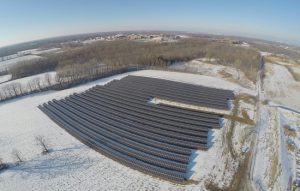Morton looks to burn bright with solar under renewable energy plan
By Holly Eitenmiller For Chronicle Media — May 1, 2018
In 2015, the Burroughs family installed a 50-panel 24.9 kilowatt array for use in powering the Burroughs Farms, LLC facility at 25356 Cooper Road in Morton. Scott Burroughs said a portion of the $70,000 cost was offset by a USDA grant and solar credits. The array supplies a large portion of the company’s electricity needs, but in retrospect, he said, it should have been a little larger. (Photo by Holly Eitenmiller / Chronicle Media)
There may be sunlight streaming into power outlets and light switches once new solar farms begin popping up in central Illinois.
In December 2016, Illinois state legislators passed Senate Bill 2814, The Future Energy Jobs Act, an update of the state’s existing renewable energy portfolio, and the FEJA is packed with provisions for energy efficiency, renewable energy, zero emissions credits and low-income job training programs.
Among them, a community solar program that will allow citizens to implement, and benefit from privately-owned solar farms.
“Illinois is a deregulated state. It’s similar to coal plants being privately owned,” said Trajectory Energy Partners President Jon Carson of community solar farms. “The state would like to see these farms sprinkled all over, it’s enormously helpful to our grid.” The bill, he said, calls for 25 percent of Illinois power production to be renewable by 2025.
Carson is a civil engineer and community organizer who served as chief of staff at White House Office of Environmental Quality during the Obama administration.
Carson and members of the Trajectory Energy team are networking throughout Illinois, and were present at the Morton Economic Development Council’s April 23 Community Solar Open House.
Morton Chamber of Commerce director Leigh Ann Brown said Morton is eying the potential for a solar farm on land being proposed along Tennessee Avenue.
“There’s a lot happening in solar, residential, commercial and community,” she said. “We are collecting informational sheets that answer questions for businesses citizens.”
The bill allows for communities to build 2 megawatt solar farms, Carson said, which generally require around 16 acres to install 7,000 3-foot-by-6-foot solar panels.
A solar farm of that size can generate enough electricity to power about 500 homes in a year. Not enough for communities to end the use of non-renewable resources, such as coal, he said, but it’s a start.
“The great thing about solar is that it’s at its most productive at the same time that we have our highest demand,” Carson said.
During the hot summer months, it will help offset high use of air conditioners, and, during the bitter, cold winter months, the increased demand for heat.
For solar power to be returned to the power grid, solar farms must be situated near a three-phase line, he said. Single-phase lines are often located in rural areas, where power loads are lighter.
Solar-generated electricity is returned to the power grid from the three-phase line, where it is redistributed to the consumer.
“It’s a lot like the grain elevators. The farmers bring the grain to one location and where it’s redistributed,” Carson explained. “You may not get the corn that was grown in your community, but you’ll get the same amount in return.”
In November, voters in Fondulac Township opted to lease Trajectory Energy 18 acres of Sunnyland farmland between Dundee Road and Cherry Lane for $800 per acre with a 2 percent escalation cost over 24 years. The agreement will generate almost $500,000 for the township over the length of the lease.
Trajectory Energy has also negotiated with Peoria County on four solar farms; two near Brimfield and two west of Peoria near the Peoria County Correctional Center. Trajectory Energy, however, is not the only solar energy developer vying for tenancy in the area.
Cypress Creek Renewables of Santa Monica, Calif. is submitted plans to the Tazewell County Zoning Board of Appeals in January to build a 2 megawatt facility on 30 acres of land near the intersection of Illinois Route 29 and East Manito Road. Cypress Creek also has four bids in with the McLean County Board.

Two years ago, the Rochester Institute of Technology installed this 2-megawatt solar energy farm, which is tied directly into the college’s central substation. The power is then distributed throughout the 1,300-acre campus. (Photo courtesy of RIT University News)
Though competition between solar energy developers is stiff, the outcome is generally the same. Each project costs developers around $3.3 million to build a 2 megawatt solar farm, comprised of 7,000 solar panels on around 15 acres of land.
In some cases, that land is a brownfield; an area previously developed, such as a landfill, but which is not currently in use.
Carson said land surrounding the solar arrays is often planted with a range of plants, grasses and flowers that attract pollinating species of birds and insects.
Regardless of which developer lands which bid, the decision on which community will be granted a solar farm under the FEJA bill remains in the hands of the Illinois Power Agency.
Carson said once Trajectory Energy and its competitors gain approval from various municipalities and counties, those projects must then be submitted to the IPA, to be pooled, then chosen through a lottery selection process.
“There are more projects that will be applied for then will actually be approved,” he said. “They’ll hold a lottery, and those who aren’t picked will be first in line for the next lottery selection.”
The IPA is expected to conduct that lottery this fall, and construction of the chosen solar farms may begin immediately afterward, so that power may begin being added to the local power grid as soon as 2019.
Carson said that when solar farms are permitted to grow in size from 2 kilowatts, energy storage battery systems may be added so that solar energy may be stored, rather than fed directly into the grid.
—- Morton looks to burn bright with solar under renewable energy plan —-




